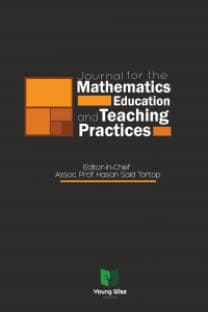Activity for teaching mathematics for students with learning disabilities with analogy method : division with and without a remainder topic
Activity for teaching mathematics for students with learning disabilities with analogy method : division with and without a remainder topic
One of the subjects that students with mathematics learning difficulties have difficulty with is division with and without remainders. In teaching this subject, concretization, use of analogy and gamification can be effective in understanding. Concretization, semi-concrete, abstract teaching strategy is applied. In this article, an activity for teaching division in students with mathematics learning difficulties is presented.
Keywords:
division, dyscalculia, analogy teaching practices in math education,
___
- Albayrak, M. (2010). Eğitim Fakülteleri ve Sınıf Öğretmenleri İçin İlköğretimde Matematik ve Öğretimi-I Mathematics and Teaching in Primary Education for Education Faculties and Class Teachers-I (3rd Ed). Erzurum: Mega Ofset Matbaacılık.
- Baykul, Y. (2002). Teaching Mathematics in Primary Education. 6th edition. Ankara: Pegem A Yayıncılık.
- Butterworth, B. (2005). Developmental Dyscalculia. In. J. I. D. Campbell (Ed.), Handbook of Mathematical Cognition (pp. 455–467). New York, NY: Psychology Press.
- Butterworth, B. (2005). Developmental Dyscalculia. In. J. I. D. Campbell (Ed.), Handbook of Mathematical Cognition (pp. 455–467). New York, NY: Psychology Press.
- Chodura, S., Kuhn, J. T., & Holling, H. (2015). Interventions for children with mathematical difficulties. Zeitschrift Für Psychologie, 223(2), 129-144. https://doi.org/10.1027/2151-2604/a000211
- Filiz, T. (2021). Matematik Öğrenme Güçlüğü Yaşayan Öğrencilere Yönelik Öğretimsel Müdahalelerin Öğrencilerin Akademik Başarılarına Etkisinin İncelenmesi, The Effects of Instructional Interventions on the Academic Achievement of Students with Mathematical Learning Difficulties. Ankara Üniversitesi Eğitim Bilimleri Fakültesi Özel Eğitim Dergisi, https://doi.org/10.21565/ozelegitimdergisi.713496
- Gersten, R., Chard, D. J., Jayanthi, M., Baker, S. K., Morphy, P., & Flojo, J. (2009). Mathematics instruction for students with learning disabilities: Meta-analysis of instructional components. Review of Educational Research, 79(3), 1202-1242. https://doi.org/10.3102/0034654309334431
- Karabulut, A., & Yıkmış, A. (2010). Zihin Engelli Bireylere Saat Söyleme Becerisinin Öğretiminde Eşzamanlı İpucuyla Öğretimin Etkinliği The Effectiveness of Simultaneous Prompting on Teaching The Skill of Tellıng The Time To Individuals With Mental Retardation Abant Izzet Baysal University Journal, 10(2), 103-113.
- Kumaş, Ö. A., Dada, Ş. D., & Yıkmış, A. (2019). Öğrenme Güçlüğü Olan ve Olmayan Öğrencilerin Sözel Problem Çözme ve Okuduğunu Anlama Becerileri Arasındaki İlişkiler The Relationship Between Verbal Problem Solving and Reading Comprehension Skills of Student with and with-out Learning Disabilities. Mersin University Faculty of Education Journal 15(2), 542-554.
- Marita, S., & Hord, C. (2016). Review of mathematics interventions for secondary students with learning disabilities. Learning Disability Quarterly, 40(1), 29-40. https://doi.org/10.1177/0731948716657495
- Monei, T., & Pedro, A. (2017). A systematic review of interventions for children presenting with dyscalculia in primary schools. Educational Psychology in Practice, 33(3), 277-293. https://doi.org/10.1080/02667363.2017.1289076
- Mutlu, Ü. (2020). Saldırganlık Düzeyi ve Zorbalık Arasındaki İlişkide Sosyal Duygusal Öğrenme Becerilerinin Düzenleyici Rolü The moderator role of social emotional learning skills in therelationship between the aggression level and bullying. Master Thesis. Marmara University.
- Mutlu, Y., Olkun ,S., Akgün, L. & Sarı, H (2020). Diskalkuli Matematik Öğrenme Güçlüğü Tanımı, Özellikleri, Yaygınlığı, Nedenleri ve Tanılanması (Dyscalculia Mathematics Learning Disability Definition, Characteristics, Prevalence, Causes and Diagnosis). Ankara: Pegem.
- Olkun, S. & Akkurt, D. (2015). Temel Sayı İşleme Görevleri Kullanılarak Matematik Bozukluğu Riskli Öğrencilerin Belirlenmesi (Using Basic Number Processing Tasks in Determining Students with Mathematics Disorder Risk). Düşünen Adam The Journal of Psychiatry and Neurological Science, 28(1), 47-57.Doi: 10.5350/DAJPN2015280105.
- Oral, N. (2020). 5. Sınıf Öğrencilerinin Doğal Sayılarla Bölme İşleminde Yaşadığı Zorluklar ve Bu Zorlukların Nedenleri (The moderator role of social emotional learning skills in the relationship between the aggression level and bullying). Master thesis. Pamukkale University.
- Pandey, S. & Agarwal, S. (2014). Dyscalculia: A Specific Learning Disability Among Children. International Journal of Advanced Scientific and Technical Research, 4(2), 912-918.
- Saka, A., Ayas, A. & Enginar, İ. (2002, Eylül). Öğrencilerin, Omurgalı-Omurgasız Canlılar İle İlgili Görüşlerinin Yaşlara Göre Değişimi (Changes of Students' Views on Vertebrate-Invertebrate Creatures by Age). 5. Ulusal Fen Bilimleri ve Matematik Eğitimi. Ankara: Orta Doğu Teknik Üniversitesi.
- Shalev, R. S. (2007). Prevalence of Developmental Dyscalculia. In D. B. Berch & M. M. M. Mazzocco (Eds.), Why is math so hard for some children? The nature and origins of mathematical learning difficulties and disabilities (pp. 49–60). Baltimore, MD: Paul H. Brookes.
- Shalev, R. S., Manor, O., & Gross-Tsur, V. (2005). Developmental Dyscalculia: A Prospective Six-Year Follow-Up. Developmental Medicine & Child Neurology, 47, 121–125. doi: 10.1017/S0012162205000216
- Şahin, F. (2000). Okul Öncesinde Fen Bilgisi Öğretimi ve Aktivite Örnekleri (Science activities for early childhood education). İstanbul: YaPa Yayınları. Şahin (2016), Analogy method in pre-school science education and to what extend analogy takes part in preschool education programs. International Journal of Turkish Education Sciences, 4(6), 48-61.
- Yayın Aralığı: Yılda 2 Sayı
- Başlangıç: 2020
- Yayıncı: Genç Bilge Yayıncılık
